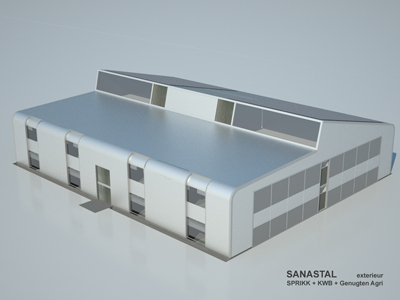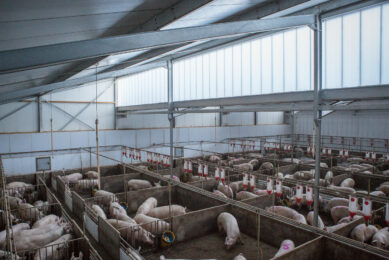Sanastal – Housing with new technology for fattening pigs

KWB Boxtel is working closely together with SPRIKK Architecture based in Rotterdam and Genugten Agri based in Sint Oedenrode on the realisation of the Sanastal.
The Sanastal (see photos below) is an animal housing concept that integrates a range of new technologies in the areas of air scrubbing, air circulation, and the use of passive energy and energy recovery to produce a house for fattening pigs which greatly improves living conditions for the animals as well as people. The name says it: Sanastal stands for ‘healthy animal house.’
In 2010, a team of experts carried out a feasibility study comparing the extra costs of this concept to the extra ‘benefits’ in energy savings, less use of antibiotics, reduced veterinary costs, increased growth (higher yield) and higher quality of meat (Dutch 1-star certification awarded by the Animal Protection Society as a quality mark of animal-friendly, sustainable production).
Environmental benefits
The environmental benefits (energy-neutral, minimum emissions) are realised via innovative technologies such as the new multiphase air scrubber from KWB in Boxtel, UV technology and energy-saving techniques, including high-yield heat exchanger, solar cells, online data control and, in particular, the method used to quickly remove manure from the house. The animal welfare benefits are realised via the innovative housing design.
The environmental benefits (energy-neutral, minimum emissions) are realised via innovative technologies such as the new multiphase air scrubber from KWB in Boxtel, UV technology and energy-saving techniques, including high-yield heat exchanger, solar cells, online data control and, in particular, the method used to quickly remove manure from the house. The animal welfare benefits are realised via the innovative housing design.
The animals are held in a multilevel system with ample freedom of movement, ‘toys’ and exercise possibilities. The innovative housing design ensures optimum penetration of daylight, a strict separation between ‘clean’ and ‘dirty’ pathways, a very attractive exterior (socially acceptable aesthetics, transparent, in harmony with the landscape) and an acceptable increase in building and running costs. In terms of animal welfare, the aim is to ensure that the meat produced in the new house will be awarded at least a 1-star certification.
The central climate control unit not only removes pathogens from incoming and outgoing air via a UV system but, in combination with the sophisticated energy recovery and air cooling system, also ensures a stable house climate and flow of ventilation air. As a result, the animals show better growth (improved feed conversion) and little or no antibiotics are needed. The multiphase biological air scrubber keeps the emissions of odours, ammonia and fine particulate matter under control.
The unique design also ensures that the house fits in well with the landscape and gives it a high-quality, reassuring look that confirms its added value in terms of animal welfare and a healthier, more sustainable meat production for the consumer.











